Carbonate platform
A carbonate platform is a sedimentary body which possesses topographic relief, and is composed of autochthonous calcareous deposits (Wilson, 1975). Platform growth is mediated by sessile organisms whose skeletons build up the reef or by organisms (usually microbes) which induce carbonate precipitation through their metabolism. Therefore, carbonate platforms can not grow up everywhere: they are not present in places where limiting factors to the life of reef-building organisms exist. Such limiting factors are, among others: light, water temperature, transparency and pH-Value. For example, carbonate sedimentation along the Atlantic South American coasts takes place everywhere but at the mouth of the Amazon River, because of the intense turbidity of the water there (Carannante et al., 1988). Spectacular examples of present-day carbonate platforms are the Bahama Banks under which the platform is roughly 8 km thick, the Yucatan Peninsula which is up to 2 km thick, the Florida platform,[1] the platform on which the Great Barrier Reef is growing, and the Maldive atolls. All these carbonate platforms and their associated reefs are confined to tropical latitudes.[2] Today’s reefs are built mainly by scleractinian corals, but in the distant past other organisms, like archaeocyatha (during the Cambrian) or extinct cnidaria (tabulata and rugosa) were important reef builders.
Carbonate sedimentation
The mineralogic composition of carbonate platforms may be either calcitic or aragonitic. Seawater is oversaturated in carbonate, so under certain conditions CaCO3 precipitation is possible. Carbonate precipitation is thermodynamically favoured at high temperature and low pressure. Three types of carbonate precipitation are possible: biotically controlled, biotically induced and abiotic. Carbonate precipitation is biotically controlled when organisms (such as corals) are present that exploit carbonate dissolved in seawater to build their calcitic or aragonitic skeletons. Thus they may develop hard reef structures. Biotically induced precipitation takes place outside the cell of the organism, thus carbonate is not directly produced by organisms, but precipitates because of their metabolism. Abiotic precipitation involves little or no biological influence.
Classification
The three types of precipitation described above determine different platform geometries. According to these characteristics a classification was created, consisting of three types of carbonate factories. A carbonate factory is the ensemble of the sedimentary environment, the intervening organisms and the precipitation processes that lead to the formation of a carbonate platform (Schlager, 2005).
Tropical factory
In these platforms precipitation is biotically controlled, mostly by autotrophic organisms. Organisms that build this kind of platform are mostly corals, green algae, foraminifers and molluscs. These platforms are found only in warm (more than 20°C) and sunlit waters, high in oxygen and low in nutrients. This means that they are found between 30° north and 30° south of the equator. This type of factory is the most widespread today, and is often found fossilised.
Cool-water factory
As the name suggests, this type of platform extends its domain to cooler waters and higher latitudes than tropical factories. Precipitation is biotically controlled by heterotrophic organisms, sometimes in association with photo-autotrophic organisms such as red algae. The sea-waters of these platforms are characterised by a higher amount of nutrients than in tropical factories.
Mud-mound factory
These platforms are characterised by abiotic precipitation and biotically induced precipitation. They grow in waters high in nutrients and low in oxygen. Mud-mound factories are known only from the fossil record, especially Palaeozoic and Mesozoic.
Geometry of carbonate platforms
Several factors influence the geometry of a carbonate platform, including inherited topography, synsedimentary tectonics, exposition to currents and trade winds. However, the one most important factor is perhaps the type of carbonate factory. Thus, cool-water factories tend to generate ramps, tropical factories usually form high-relief rimmed platforms and mud-mounds, mound-shaped high relief bodies without a clear zone of dip break. The best known platform geometry, however, is that of modern tropical factories. Tropical carbonate platforms can be subdivided into three principal sedimentary environments: reef, internal lagoon and slope.
Reef
The reef is that part of a carbonate platform created by essentially in-place, sessile organisms. Today’s reefs are built by hermatypic organisms. The reef is the rigid structure of carbonate platforms and is located between the internal lagoon and the slope. Survival of the platform depends on the existence of the reef, because only this part of the platform can build a rigid, wave-resistant structure. Two reef types are distinguished: isolated (as Maldives atolls) or epicontinental (as the Belize reefs or the Florida Keys). Geologically speaking, reef rocks can be classified as massive boundstones.
Internal lagoon
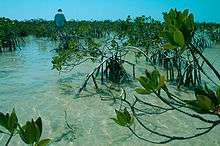
The internal lagoon, as the name suggests, is the part of platform behind the reef. It is characterised by shallow and calm waters. Sediments are composed of reef fragments and hard parts of organisms. If the reef is epicontinental there can be also a terrigenous contribution. In some lagoons (e.g., the Florida Bay) green algae produce great volumes of carbonate mud. Rocks here are mudstones to grainstones depending on the energy of the environment.
Slope
The slope is the outer part of the platform, connecting the reef with the basin. This area acts as sink for excess carbonate sediment: most of the sediment produced in the lagoon and reef is transported by various processes and accumulates in the slope. Therefore, the slope contains coarser sediments than the reef and lagoon; these rocks are generally rudstones or grainstones. Sediments have a characteristic geometry: they are organized in clinoforms. Clinoforms are beds that have a sigmoidal or tabular shape, but are always deposited with a primary inclination.
Carbonate platforms in the geological record
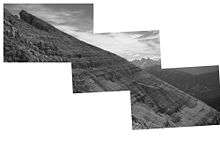
Sedimentary sequences show carbonate platforms as old as the Precambrian, when they were formed by stromatolitic sequences. In the Cambrian carbonate platforms were built by archaeocyatha, metazoa similar to porifera. During Paleozoic brachiopod (richtofenida) and stromatoporoidea reefs were erected. At the middle of the Paleozoic era corals became important platforms builders, first with tabulata (from the Silurian) and then with rugosa (from the Devonian). Scleractinia become important reef builders beginning only in the Carnian (upper Triassic). One of the best examples of a carbonate platform is the Dolomites, deposited during the Triassic. This region of the Southern Alps contains many well preserved atolls, including the Sella, Gardenaccia, Sassolungo and Latemar, the latter being a backstepping type platform. The middle Liassic "bahamian type" carbonate platform of Morocco (Septfontaine, 1985) is characterised by the accumulation of autocyclic regressive cycles and spectacular supratidal (top of sequences) deposits and vadose diagenetic features with dinosaur tracks. The Tunisian coastal "chotts" and their cyclic muddy deposits represent a good recent equivalent (Davaud & Septfontaine, 1995). Such cycles were also observed on the mesozoic Arabic platform, Oman and Abu Dhabi (Septfontaine & De Matos, 1998) with the same microfauna of foraminifera in an almost identical biostratigraphic succession.
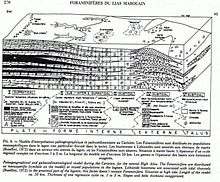
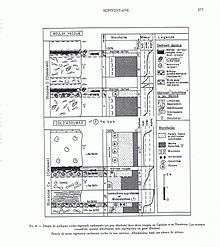
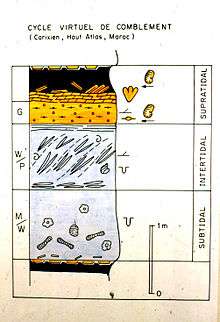
In the Cretaceous period there were platforms built by bivalvia (rudists).
Gallery
 "Shallowing upward" cycle in the middle Lias of the high Atlas (Morocco). Algal dolomitized laminations on top.
"Shallowing upward" cycle in the middle Lias of the high Atlas (Morocco). Algal dolomitized laminations on top. "Shallowing upward" cycles in the lagoonal Lias of the Musandam Peninsula. (N-Oman).
"Shallowing upward" cycles in the lagoonal Lias of the Musandam Peninsula. (N-Oman). "Shallowing upward" liassic cycles arranged in decametric sequences, Musandam Peninsula, (N-Oman).
"Shallowing upward" liassic cycles arranged in decametric sequences, Musandam Peninsula, (N-Oman).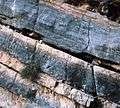 "Shallowing upward" cycle in the Middle Jurassic (Saghtan form.) of the jbel Laghdar Range (Oman).
"Shallowing upward" cycle in the Middle Jurassic (Saghtan form.) of the jbel Laghdar Range (Oman).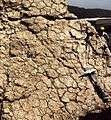 Desiccation figures on top of a regressive sequence; Middle liassic, High Atlas, Morocco.
Desiccation figures on top of a regressive sequence; Middle liassic, High Atlas, Morocco. Ammonites and belemnites washed over a supratidal surface (calcretes and "teepees"); Middle Liassic of the High Atlas, Morocco.
Ammonites and belemnites washed over a supratidal surface (calcretes and "teepees"); Middle Liassic of the High Atlas, Morocco. Hurricane breccia cemented (early diagenesis) at the surface of a bed, top of a regressive, metric, sequence. Middle Lias, High Atlas.
Hurricane breccia cemented (early diagenesis) at the surface of a bed, top of a regressive, metric, sequence. Middle Lias, High Atlas.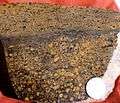 Vadose ferrugenous pisolites (soil) and coastal (tempestite) sediment with birdseyes in an outer platform environment. Aerial diagenesis. Middle liassic, High Atlas, Morocco.
Vadose ferrugenous pisolites (soil) and coastal (tempestite) sediment with birdseyes in an outer platform environment. Aerial diagenesis. Middle liassic, High Atlas, Morocco. Meniscus and point contact cement in a marine grainstone with displaced foraminifera (by tide and hurricanes) on the supratidal flat of the middle liassic platform of Morocco. Top of emersive cycle. Middle Atlas.
Meniscus and point contact cement in a marine grainstone with displaced foraminifera (by tide and hurricanes) on the supratidal flat of the middle liassic platform of Morocco. Top of emersive cycle. Middle Atlas. Reworked calcretes concretions from the supratidal environment in a marine (dolomitised) sediment displaced by hurricanes on the inner platform flat. Top of emersive sequence. High Atlas, Morocco.
Reworked calcretes concretions from the supratidal environment in a marine (dolomitised) sediment displaced by hurricanes on the inner platform flat. Top of emersive sequence. High Atlas, Morocco. Stalactitic cement in sediment from the supratidal zone, vadose environment, top of "shallowing upward" sequence. Middle Liassic, High Atlas. Thin section. L = 0.3 mm.
Stalactitic cement in sediment from the supratidal zone, vadose environment, top of "shallowing upward" sequence. Middle Liassic, High Atlas. Thin section. L = 0.3 mm.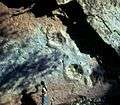 Giant dinosaur tracks (sauropod) on top of a regressive sequence, Middle Liassic, High Atlas, Morocco.
Giant dinosaur tracks (sauropod) on top of a regressive sequence, Middle Liassic, High Atlas, Morocco. Vadose stalactitic cement filling an horizontal cavity in a marine coastal sediment, outer platform. Birdseyes in the allodapic (tidal or tempestite) grainstone point to an aerial diagenesis. High Atlas, Morocco.
Vadose stalactitic cement filling an horizontal cavity in a marine coastal sediment, outer platform. Birdseyes in the allodapic (tidal or tempestite) grainstone point to an aerial diagenesis. High Atlas, Morocco.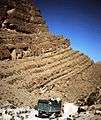 Autocyclic filling (metric to hectometric) sequences in the Middle Liassic lagoon, South (Todhra) of the High Atlas, Morocco.
Autocyclic filling (metric to hectometric) sequences in the Middle Liassic lagoon, South (Todhra) of the High Atlas, Morocco. "Teepee" structure, due to increasing sediment volume by dolomitisation on the inner platform supratidal flat. Top of emersive cycle. Middle Lias, High Atlas.
"Teepee" structure, due to increasing sediment volume by dolomitisation on the inner platform supratidal flat. Top of emersive cycle. Middle Lias, High Atlas. Quaternary to recent equivalent of a "shallowing upward sequence", cores in a Tunisian "chott", intertidal laminations in yellow.
Quaternary to recent equivalent of a "shallowing upward sequence", cores in a Tunisian "chott", intertidal laminations in yellow. Recent "teepee" structures in a Tunisian salt lagoon, "chott".
Recent "teepee" structures in a Tunisian salt lagoon, "chott". Recent equivalents of "shallowing upward sequences", cores in a Tunisian salt lagoon, "chott".
Recent equivalents of "shallowing upward sequences", cores in a Tunisian salt lagoon, "chott".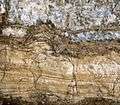 Top of a regressive sequence with algal laminations (yellow) and crystallised gypsum, salt lagoon "chott", Tunisia.
Top of a regressive sequence with algal laminations (yellow) and crystallised gypsum, salt lagoon "chott", Tunisia.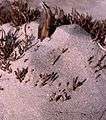 Eolian bioclastic (calcareous algae and porcellaneous foraminifera) sand dune on Tunisian shore.
Eolian bioclastic (calcareous algae and porcellaneous foraminifera) sand dune on Tunisian shore.
See also
Footnotes
- ↑ Geologic Map of Florida
- ↑ "Archived copy". Archived from the original on 2008-05-16. Retrieved 2007-03-12.
References
- Carannante G., Esteban M., Milliman J. D., Simone L., 1988, Carbonate lithofacies as paleolatitude indicators: problems and limitations. Sedimentary Geology, Vol. 60, pp. 333–346.
- Davaud E. & Septfontaine M. (1995): Post-mortem onshore transportation of epiphityc foraminifera: recent example from the Tunisian coast line.- Jour. Sediment. Research, 65/1A, 136-142.
- Schlager W., 2005, Carbonate sedimentology and sequence stratigraphy. SEPM, Tulsa, Oklahoma, 200 pp. ISBN 1-56576-116-2
- Wilson J. L., 1975, Carbonate Facies in Geologic History, Springer-Verlag, 471 pp. ISBN 3-540-07236-5
- Bosellini A., 1984, Progradation geometries of carbonate platforms: examples from the Triassic of the Dolomites, northern Italy. “Sedimentology”, Vol. 31, pp. 1-24
- "Bahamas Introduction" (Accessed 3/8/06)
- About.com: Geologic Map of Florida (Accessed 3/8/06)
- Pinet P. R., 1996, Invitation to Oceanography. St. Paul: West Publishing Company, ISBN 0-314-06339-0
- Septfontaine M. 1985, Depositional environments and associated foraminifera (lituolids)in the middle liassic carbonate platform of Morocco.- Rev. de Micropal. 28/4 265-289. See also www.palgeo.ch/publications.

